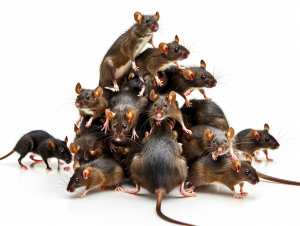
In addition to the house mouse, deer mice are also common indoor rodent pests in all areas of California. While deer mice are more abundant in California than house mice, the latter invade homes much more often than the former. Deer mice prefer to nest outdoors, but they may invade homes and buildings when climatic conditions become extreme and threatening, such as during cold winter seasons. Unlike deer mice, house mice invade homes consistently throughout the year, as this rodent species has adapted to favor indoor, as opposed to outdoor environments.
House mice are generally light brown to grey in color and weigh around half an ounce. They range from 2 to 4 inches in body length, with 3 to 4 inch long tails, and they have relatively large years and black beady eyes. House mice invade homes from the ground surface, and foundation openings, gaps beneath doors, and crevices in screened windows are some of the most common entry points. Holes as small as a nickel on the exterior walls of homes provide more than enough space for house mice to access indoor areas.
Once indoors, house mice shred fabric, paper, cardboard, insulation, and other materials in order to use the scraps as a material to build nests, which they establish in hidden areas. Unlike deer mice, house mice have not been found to spread Hantavirus, but they do spread a variety of disease-causing microorganisms within homes, particularly within kitchen cabinets and pantries where they access stored food. Fecal matter and urine is usually present within food packages that have been accessed by house mice, and such food items should be immediately discarded to protect against disease, including Salmonella and E. coli.
Have you ever struggled to control a mouse infestation within your home?


